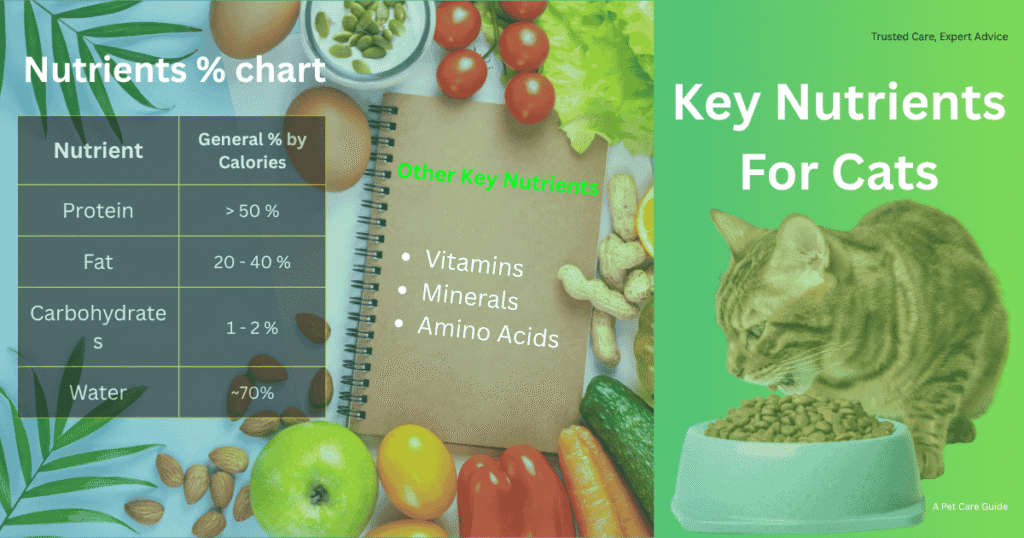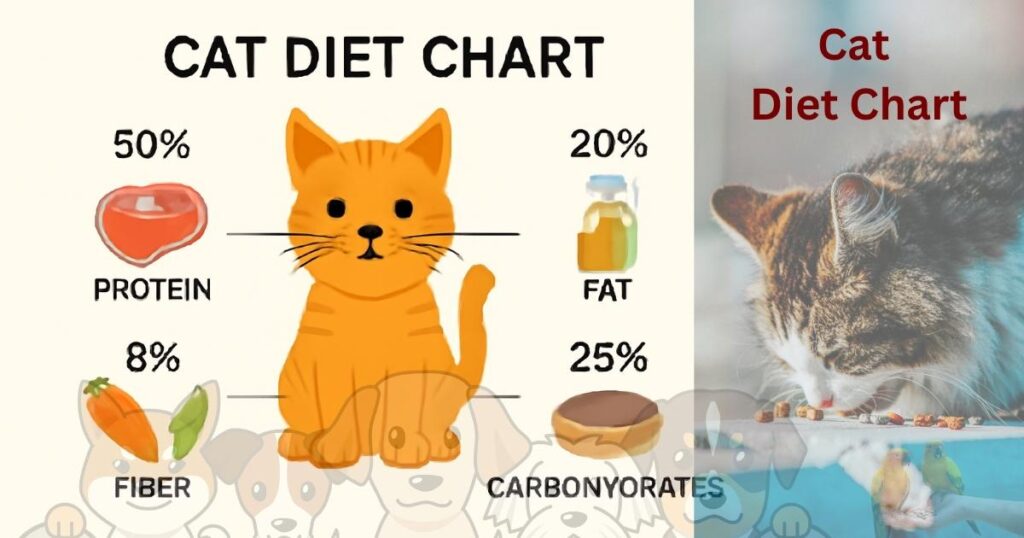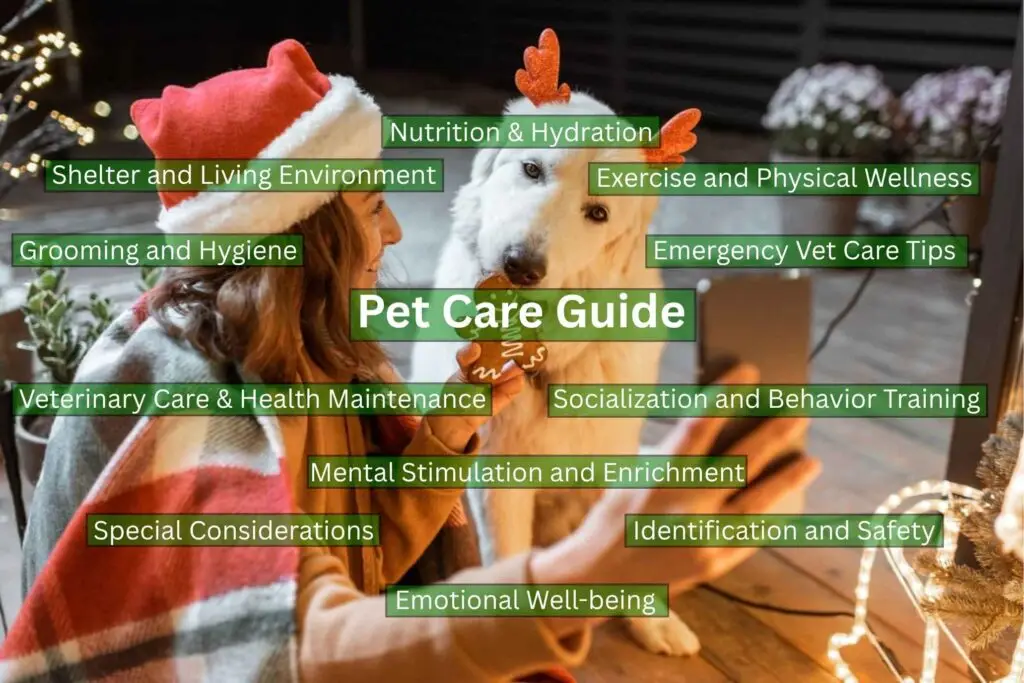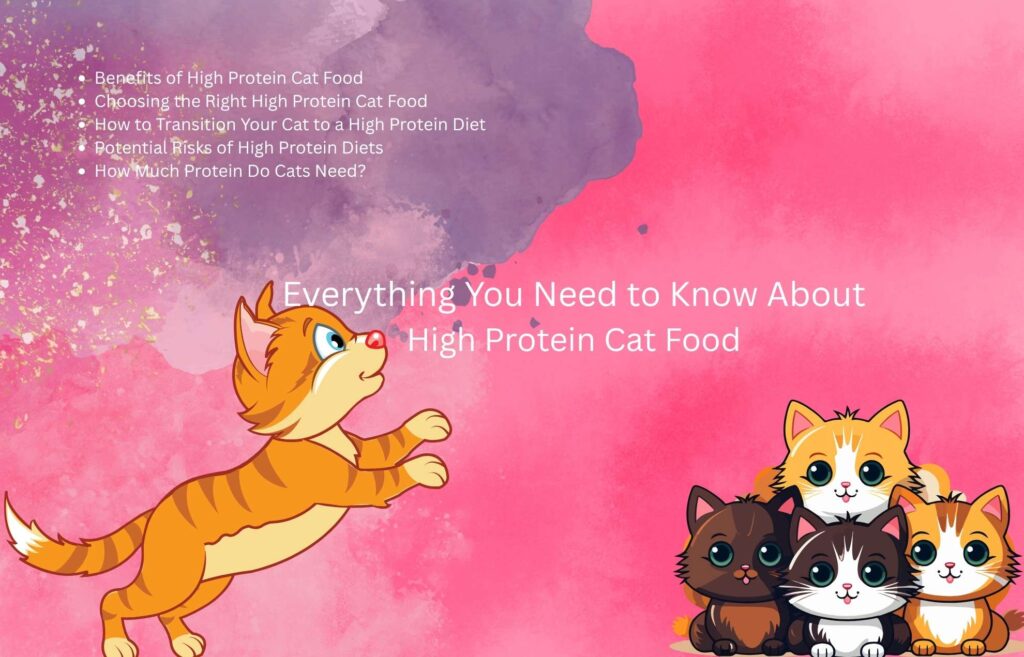Proper nutrition is crucial for your cat’s health, happiness, and overall well-being. But are you sure you’re feeding them the right amount of food? It’s a question every loving cat owner asks. The Cat Diet Chart is here to help you understand your cat’s unique needs. We will guide you through determining the right portions, selecting the best food types, and meeting the nutritional needs for every stage of your cat’s life.
Getting your cat’s diet right is one of the most important things you can do for them, as it helps prevent obesity, malnutrition, and other serious health problems. From energetic kittens to graceful seniors, we will cover the specific feeding guidelines, look at different food types, and show you how to adjust meals for your special feline friend.
Understanding Cat Nutrition
Cats as Obligate Carnivores
Have you ever wondered why your cat craves meat? It’s because they are “obligate carnivores.” This scientific term simply means their bodies are built to run on animal-based nutrients. Think of their digestive system as a highly specialized engine designed for one type of fuel: meat. They lack certain enzymes needed to break down plant matter effectively.
This is why cats absolutely need animal protein to live a full, healthy life. Their entire system is set up to digest and use proteins and fats from animal sources. A plant-based diet just doesn’t provide the essential building blocks they need, which can lead to severe health issues.
Key Nutrients for Cats

High-Quality Protein and Amino Acids
Cats are hunters, right? Their bodies are tiny, perfect engines built for meat. This is why proteins are the absolute number one thing in their diet. It’s the fuel for everything they do, from a silent stalk to a happy purr.
Protein
Think about protein as the main building block. It builds strong muscles for jumping and pouncing. Also, it keeps their fur soft and their skin healthy. Without enough, everything starts to slow down. It’s genuinely the foundation of their entire health.
Protein Sources: Look for foods with chicken, turkey, fish, lamb, and beef listed as the main ingredients. These are fantastic sources.
Essential Amino Acids
Now, proteins are made of smaller bits called amino acids. “Essential” just means the cat’s body cannot make them. They must get them from food. One of these is taurine. I’ve seen in my research what happens without it. Cats can face serious eye and heart problems. It’s a non-negotiable part of a good cat diet chart.
Arachidonic Acid
Here’s a fun fact: dogs can make this acid. Cats cannot. They must eat it. This special acid, found in animal fats, helps their body respond to swelling and keeps their organs working right. It’s another reason cats must eat meat.
Healthy Fats
Fats get a bad rap in human diets, but for cats, they are a wonderful source of energy. In fact, they provide twice the energy of proteins. Plus, let’s be honest, fat makes food taste amazing. It’s why your cat loves it so much.
Why Cats Need Fat: Fat is a major energy source for your active kitty. It also helps them absorb important vitamins (A, D, E, and K) and keeps their coat wonderfully soft and shiny.
Essential Fatty Acids
Just like with amino acids, essential means their body can’t make it. These specific fats (like omega-3s and omega-6s) are the secret to a shiny, soft coat. They also calm down itchy skin and support a healthy body.
Linoleic Acid
This is a type of omega-6 fatty acid. It’s another one that cats must get from their food. It’s a workhorse for skin and coat health. A lack of this shows up fast as flaky, dry skin and a dull-looking coat.
Vitamins
Vitamins are like the tiny spark plugs in your cat’s engine. They don’t provide energy on their own, but they make all the energy-using processes happen. And, they need a very special mix that’s different from ours.
Vitamin A
This is a big one. Again, cats are special. They can’t turn beta-carotene (like from carrots) into Vitamin A. They need the real deal from animal sources, like liver. This vitamin is critical for strong vision (especially for hunting in the dark!) and healthy skin.
Vitamins B
I think of B vitamins as the “energy-release” crew. They help the body unlock the power from food. Niacin, thiamin, and B12 are all part of this group. Since they are water-soluble, a cat’s body can’t store them well. This means they need a steady supply every single day.
Vitamin D
We get this from the sun, right? Well, cats don’t. It’s amazing! Lying in that sunbeam feels good, but it doesn’t help them make Vitamin D. Just like A, they must get it from their diet. It’s a key partner for minerals, helping bones grow strong.
Vitamins E and K
Vitamin E is a powerful protector. It helps keep body tissues safe from damage. Think of it as a little shield for their cells. And Vitamin K? That’s the blood-clotting specialist. It’s the little helper that stops bleeding from a small scratch.
Minerals
Finally, we have minerals. These are the nuts and bolts of the body. They are involved in almost everything, from strong bones to tiny nerve signals.
Calcium and Phosphorus
These two are best friends. They work together to build strong bones and teeth. The balance between them is the real magic. Too much of one or not enough of the other can cause big problems. A good cat diet chart always has this ratio perfect.
Magnesium, Potassium, and Sodium
These are the body’s communicators. They help manage nerve signals and muscle twitches (even that little sleepy twitch!). They also keep the body’s water balance just right. They are a team that keeps the internal system stable.
Iron, Zinc, Copper, and Selenium
These are called “trace” minerals, but they have huge jobs. Iron carries oxygen in the blood, which is pure energy. Zinc is wonderful for skin and healing. Copper helps use iron. Selenium acts like Vitamin E, protecting cells. You only need tiny amounts, but they are absolutely necessary for life.
High Fiber
While cats don’t need a lot of fiber, a moderate amount is fantastic for keeping their digestive system running smoothly. It helps prevent hairballs, promotes healthy bowel movements, and can even assist with weight management by helping them feel full. Look for natural sources!
Low Carbohydrates
Digestibility: Cats are not designed to digest a lot of carbohydrates. High-carb diets can, unfortunately, lead to problems like obesity and diabetes.
Natural Diet Comparison: In the wild, a cat’s carbohydrate intake is very small, mostly from the stomach contents of their prey. Their diet should reflect this low-carb reality.
How Much to Feed Your Cat
General Feeding Guidelines
Figuring out the right amount of food can feel tricky, but here are some simple starting points for a basic cat diet chart.
Kittens: These little bundles of energy are growing incredibly fast! They need about double the calories per pound compared to an adult cat.
Adult Cats: A healthy, active adult cat typically needs between 20 to 33 calories per pound of body weight each day.
Senior Cats: Older cats are usually less active and may need fewer calories, often around 180-220 calories per day, to maintain a healthy weight. Their food should also support their aging bodies, like their joints and kidneys.
Different Food Types and Their Caloric Density
Dry Food
Pros: Dry kibble is convenient, has a long shelf life, and is generally less expensive.
Cons: It’s often higher in carbohydrates and very low in moisture. This lack of water can sometimes contribute to urinary tract issues.
Recommended serving size: Always check the bag for a starting guideline based on your cat’s weight, but be prepared to adjust.
Wet Food
Pros: Wet food is a fantastic source of hydration. It also tends to have better protein and fat content and fewer carbs.
Cons: It can be more expensive and spoils quickly after being opened.
Recommended serving size: A standard 3-ounce can is usually suitable for every 3 to 3.5 pounds of body weight.
Raw Diets
Pros: This diet is the closest to what a cat would eat in the wild and is very high in protein.
Cons: There is a risk of bacterial contamination (for both you and your cat), and it can be difficult to create a nutritionally balanced meal at home.
Importance of consulting a vet: It is essential to speak with your veterinarian before starting a raw diet to do it safely and correctly.
Tailoring Portions to Individual Needs
How to Adjust Based on Activity Level
Just like people, active cats need more fuel. An outdoor cat who loves to explore will burn more calories and require more food than a calm, indoor cat who prefers napping in the sun.
Weight Management
Keeping an eye on your cat’s weight is key. For an overweight kitty, you’ll need to carefully control their portions. For an underweight cat, you may need to increase their food intake slightly.
You can tell if a cat is overweight if you can’t easily feel their ribs or see a defined waist. Regular weigh-ins can help you track your progress.
Factors That Affect Your Cat’s Food Needs
Age and Life Stages
Kittens (0-1 Year)
Higher Caloric Needs: Growing is hard work! Kittens require about twice the calories per pound of body weight compared to adults to support their rapid development.
Portion Size: Young kittens have tiny stomachs, so they need to eat small, frequent meals, often 3-4 times a day.
High-Protein, High-Fat Diet: Look for foods specifically formulated for kittens, as they are packed with the protein and fat they need to grow up strong.
Adult Cats (1-7 Years)
Calorie Range: The goal for adult cats is maintenance. They need about 20-33 calories per pound of body weight per day, depending on how active they are.
Maintenance Diet: A balanced diet helps them maintain a healthy weight, strong muscles, and great overall health.
Food Types: High-protein, low-carbohydrate foods are wonderful choices for keeping adult cats in peak condition.
Senior Cats (7+ Years)
Fewer Calories: As cats age, their metabolism often slows down. They may need fewer calories (around 180-220 per day) to avoid gaining weight.
Specific Health Needs: Senior cat food is often designed to give extra support where they need it most, such as for kidney health, joint mobility, and easy digestion.
Weight Considerations
Underweight Cats
Signs of Underweight: If you can easily see your cat’s ribs, spine, and hip bones, and they have no noticeable body fat, they may be underweight.
Feeding Strategies: Slowly increase their food portions. Choosing calorie-dense foods can help them gain weight in a healthy, steady way.
Overweight Cats
Risks of Obesity: Extra weight puts a serious strain on a cat’s body. Obesity can lead to painful joint issues, diabetes, and a shorter lifespan.
Portion Control: Precise portion control is the best tool for weight management. Use a measuring cup and select lower-calorie foods designed for weight loss.
Activity Level and Metabolism
Outdoor vs. Indoor Cats: An outdoor cat naturally gets more exercise by climbing, hunting, and exploring. In contrast, an indoor cat often leads a more relaxed life. This means the outdoor adventurer needs more calories than their indoor counterpart.
Hyperthyroidism or Hypothyroidism: Certain medical conditions can affect a cat’s metabolism. For example, hyperthyroidism can cause a cat to be hungry all the time yet lose weight, requiring a special diet and medical treatment.
Practical Tips for Feeding Your Cat
Use Manufacturer Guidelines as a Starting Point
How to read and interpret feeding charts: The feeding chart on your cat’s food bag is a good place to start. It gives you a general idea of how much to feed based on weight.
Important Caveats: Remember, this is just a guideline! Every cat is an individual. You must watch your cat’s body condition and adjust the amount of food accordingly.
Regular Monitoring of Weight
Weighing Your Cat: Tracking your cat’s weight every 2-4 weeks is a fantastic habit. You can do this by weighing yourself, then weighing yourself while holding your cat, and subtracting the difference.
Adjusting Portions Based on Weight: If you notice your cat is gaining or losing weight, you can make small, gradual changes to their food portions. This helps them stay in a healthy range.
Splitting Meals Throughout the Day
Why Cats Prefer Smaller, Frequent Meals: In nature, cats are hunters who eat several small meals throughout the day. Feeding them 3-4 smaller meals instead of one or two large ones better mimics this natural behavior.
Recommended Meal Frequency: A feeding schedule with several small meals can also help with digestion and keep your cat feeling satisfied.
Introducing Variety in Their Diet
Benefits of rotating: Offering different protein sources like chicken, turkey, beef, and fish can be beneficial. This rotation may help prevent food sensitivities from developing.
How to keep your cat from becoming finicky: Giving your cat a variety of flavors and textures (like mixing wet and dry food) can keep mealtime exciting and prevent them from becoming a picky eater.
Focusing on High-Quality Protein
Why choosing food with animal-based protein is crucial: This is the most important part of your cat’s diet. Animal protein provides the essential amino acids they can’t make themselves.
Examples of High-Quality Ingredients: When you read the label, look for named meats like chicken, turkey, lamb, tuna, salmon, or beef.
How to assess the quality of ingredients: The best cat foods list a specific meat as the very first ingredient. Avoid foods that list corn, wheat, or soy first.
Choosing the Right Cat Food
Understanding Food Labels
Ingredient Breakdown: The ingredient list is your best friend. The first ingredient should always be a high-quality animal protein, not a grain or a vague “meat by-product.”
Guaranteed Analysis: This box on the label tells you the minimum percentages of protein and fat and the maximum percentages of fiber and moisture. It helps you compare different foods.
Types of Cat Food
Dry Food
Caloric Density of Dry Food: Dry food is very concentrated in calories. This means a small amount goes a long way, so portion control is extremely important.
Pros and Cons: While convenient and affordable, its low moisture content is a downside. If you feed mainly dry food, make sure your cat drinks plenty of water.
Wet Food
Hydration Benefits: Wet food’s high moisture content is excellent for hydration and supports urinary tract health, which is a common concern for cats.
Protein and Fat Content: Generally, wet food has more protein and fat and fewer carbohydrates, which more closely matches a cat’s ideal diet.
Raw or Freeze-Dried Diets
Pros: These diets are considered more natural and are high in protein and moisture.
Cons: They come with safety concerns about bacteria. They are also more expensive and require careful handling and balancing of nutrients.
Transitioning to Raw Diets: If you are considering a raw diet, it’s vital to do it under the guidance of a veterinarian to make sure it’s done safely and provides complete nutrition.
Specific Brands and Products to Consider
Best Wet Food Options: Top wet food brands often feature a named meat as the first ingredient, have no artificial preservatives, and are low in fillers like corn and soy.
Best Dry Food Options: Recommended dry foods will also have high-quality protein at the top of the ingredient list and be formulated for your cat’s specific life stage (kitten, adult, or senior).
Vet-Approved Brands: Several brands work closely with veterinary nutritionists to develop science-backed formulas. Your vet can recommend brands they trust.
Special Considerations in Cat Feeding
Feeding Multiple Cats
Managing Different Diets for Multiple Cats: If you have a kitten and a senior cat, they can’t eat the same food. Their nutritional needs are completely different.
Separation During Feeding: The easiest way to manage this is to feed them in separate rooms. This prevents the faster eater from stealing food and makes sure each cat gets the right meal and the correct amount.
Cats with Special Dietary Needs
Food Allergies
Some cats can develop allergies to common ingredients. Your vet can help you identify the cause and find a suitable hypoallergenic food.
Medical Conditions
Diabetes: Diabetic cats need a diet that is high in protein and very low in carbohydrates to help manage their blood sugar.
Kidney Disease: Cats with kidney issues often need a special diet that is lower in protein and phosphorus to reduce the workload on their kidneys.
Obesity: Overweight cats benefit from a low-calorie, high-protein diet that helps them feel full while losing weight.
Senior Cats: Feeding with Health Issues
Joint Support
Many senior foods include supplements like glucosamine and chondroitin to help support aging joints and ease arthritis pain.
Kidney and Digestive Health
Specialized senior diets are often formulated to be gentler on the kidneys and easier to digest for older cats.
Cats with Food Sensitivities or Allergies
Common Allergies: Ingredients like grains, fish, dairy, or beef can sometimes trigger allergic reactions.
Hypoallergenic Food Options: Your vet might recommend a prescription diet with a novel protein (like duck or venison) or a hydrolyzed protein diet for sensitive cats.
Cat Constipation
For cats prone to constipation, a diet higher in fiber or moisture (from wet food) can help keep things moving smoothly.
Common Feeding Mistakes to Avoid
Overfeeding vs. Underfeeding
One of the biggest mistakes is giving too much food. Overfeeding leads to obesity, which is a serious health risk. On the other hand, underfeeding can lead to nutritional deficiencies. Watch your cat’s body condition carefully to find the right balance.
Feeding Only One Type of Food
Relying only on dry food can leave your cat dehydrated, while feeding only one flavor of wet food can create a picky eater. A mix of wet and dry food often provides a great balance of hydration, nutrition, and convenience.
Not Considering Portion Sizes
Simply filling the bowl whenever it’s empty is a recipe for weight gain. Use a measuring cup for every single meal to be precise. Adjusting portions based on your cat’s actual needs, not just guesswork, is the key to a healthy weight.
How to Transition Your Cat to a New Diet
Gradual Transition Process
Step-by-Step Guide: Never switch your cat’s food suddenly! This can cause an upset stomach. Instead, transition them over 7-10 days. Start by mixing a small amount of the new food (about 25%) with their old food (75%). Every couple of days, slowly increase the amount of new food until you’ve fully switched over.
Symptoms to Watch For: Keep an eye out for any digestive issues during the change.
Importance of Patience: Some cats are resistant to change. Be patient and take the transition slowly.
Monitoring for Digestive Issues
Signs Your Cat is Not Adjusting Well: If you notice vomiting, diarrhea, or your cat refusing to eat, the transition might be going too fast.
What to Do: If problems continue, slow down the transition or talk to your vet. They can help you find a solution if your cat is struggling with the new food.
Consulting with a Veterinarian
Tailored Feeding Plans
Creating a Customized Diet Plan: Your veterinarian is your best partner in your cat’s health. They can help you create a personalized cat diet chart that considers your cat’s age, weight, health status, and lifestyle.
Nutritional Supplements
When supplements are necessary: Most complete and balanced cat foods provide everything a healthy cat needs. However, a vet might recommend supplements like omega-3s for skin health or probiotics for digestion if your cat has a specific health issue.
Final Thoughts About Cat Diet Chart
Creating the perfect diet for your cat is an act of love. By choosing high-quality, protein-rich food, paying close attention to portion sizes, and regularly monitoring your cat’s weight, you are setting them up for a long, vibrant, and happy life. Remember to use these guidelines as your starting point, and always work with your vet to create a plan that is just right for your unique feline friend. Take action today to review your cat’s diet—they are counting on you!
Frequently Asked Questions (FAQ) about the Cat Diet Chart
Q1: How can I tell if my cat is overweight?
A good way is to use a Body Condition Score. You should be able to feel your cat’s ribs with a slight fat covering, but they shouldn’t be visible. When you look at them from above, you should see a clear waist behind the ribs. If you can’t feel their ribs or see a waist, they are likely overweight.
Q2: Is it okay to mix wet and dry cat food?
Yes, it’s a great idea! Mixing wet and dry food, or feeding them at separate meals, is a wonderful way to add much-needed hydration to your cat’s diet while still getting the convenience and dental benefits of kibble. It also adds variety to keep them interested.
Q3: How do I safely switch my cat to a new food?
The key is to do it slowly. A safe transition takes about 7-10 days. Start by mixing a small amount of the new food with their old food and gradually increase the proportion of new food every few days until the switch is complete.
Q4: My cat seems hungry all the time. Should I feed them more?
Not necessarily. Constant begging for food could be a sign of boredom, a cry for attention, or even a medical issue like hyperthyroidism or diabetes. Before you increase their food, check their weight and body condition. If they are at a healthy weight, try offering playtime instead of food. If the behavior continues, it’s best to consult your vet.


